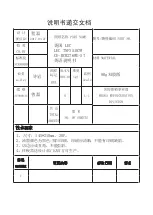
10
Door Closing and Alignment
Your refrigerator has two front adjustable rollers – one on
the right and one on the left. If your refrigerator seems
unsteady or you want the doors to close easier, adjust the
refrigerator's tilt using the instructions below:
1. Roll out the refrigerator and use a level to check the
floor at the back from side-to-side. If needed, use
shims to level the back of the refrigerator if it is uneven.
Roll the refrigerator back into place with the rear rollers
on top of any shim(s) used so that the rear of the
refrigerator is level.
2. With the rear already level and the refrigerator in place,
use the bottom leveling screws to level the refrigerator
from side-to-side. They are part of the front roller
assemblies, which are found at the base of the
refrigerator on either side.
NOTE: Having someone push against the top of the
refrigerator takes some weight off the leveling screws
and rollers. This makes it easier to adjust the screws.
Style 1
Style 2
3. Depending on your model, to level your refrigerator you
may either turn the screw clockwise to raise that side of
the refrigerator or turn the screw counterclockwise to
lower that side. Place a level on top of the refrigerator
to check adjustments.
4. If the doors do not close on their own, you will need to
raise the front of the refrigerator so it is slightly higher
than the back. To do this, turn both leveling screws
clockwise
¹⁄₂
turn.
IMPORTANT: Be sure to turn both screws an equal
amount or the refrigerator will no longer be level side-
to-side.
5. Open doors and check if they close automatically. If
not, repeat steps 3 and 4.
6. Using a level, check to see if the refrigerator is still level
side-to-side. Readjust if necessary.
Understanding Sounds
You May Hear
Your new refrigerator may make sounds that your old one
didn’t make. Because the sounds are new to you, you
might be concerned about them. Most of the new sounds
are normal. Hard surfaces, like the floor, walls, and
cabinets, can make the sounds seem louder than they
actually are. The following describes the kinds of sounds
and what may be making them.
■
If your product is equipped with an ice maker, you will
hear a buzzing sound when the water valve opens to fill
the ice maker for each cycle.
■
The defrost timer will click when the automatic defrost
cycle begins and ends. Also, the Thermostat Control
(or Refrigerator Control depending on the model), will
click when cycling on and off.
■
Rattling noises may come from the flow of refrigerant,
the water line, or items stored on top of the refrigerator.
■
Your refrigerator is designed to run more efficiently to
keep your food items at the desired temperature. The
high efficiency compressor may cause your new
refrigerator to run longer than your old one, and you
may hear a pulsating or high-pitched sound.
■
Water dripping on the defrost heater during a defrost
cycle may cause a sizzling sound.
■
You may hear the evaporator fan motor circulating the
air through the refrigerator and freezer compartments.
■
As each cycle ends, you may hear a gurgling sound
due to the refrigerant flowing in your refrigerator.
■
Contraction and expansion of the inside walls may
cause a popping noise.
■
You may hear air being forced over the condenser by
the condenser fan.
■
You may hear water running into the drain pan during
the defrost cycle.
Summary of Contents for CT14NKXJN00
Page 23: ...23 Notes ...
Page 24: ...24 Notes ...











































